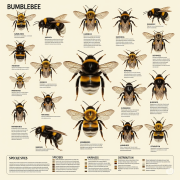A bumblebee ID chart is a visual guide that helps you identify different species of bumblebees based on their physical features. It’s commonly used by gardeners, students, nature lovers, and scientists to observe and learn more about the bumblebees in their area.
A Bumblebee ID Chart: What’s the Role?
It can be difficult to identify due to differences in the pattern of color, body segmentation, and pilosity. Tail color, thorax bands, and abdominal patterns are all consolidated into one easy-to-understand element on an identification chart.
If you want to use a chart:
- Monitor the local flora and fauna
- Back environmental protection initiatives
- Promote community-based research and data gathering
- Bring attention to the importance of health and the necessity for suitable habitats.
Important Distinguishing Traits
-
Pigment Shade
One of the simple yet fast way to identify bumblebee species is by looking at their tail color, which comes in buff, white, or red. It is easy to distinguish red-tailed bumblebees from white-tailed ones. However, the red-colored tail is noticeable for both the Garden bumblebee and the tree bumblebee.
-
Latitudinal and Abdominal Bands
Check the belly and thorax for any bands, either single or double. A red center band is characteristic of a Red-tailed bumblebee (Bombus lapidarius), but a buff or yellow band directly behind the head could be an indication of a Buff-tailed bumblebee (Bombus terrestris).
-
The Thickness and Feel of Hair
Long setae cover the fuzzy bodies of bumblebees. Differentiating between parasitic and nesting bumblebees is made easier by looking at the workers’ thick fur and pollen baskets compared to cuckoo bumblebees’ evenly hairy hind legs.
Field Applications of This Chart
 Take note of the bumblebee’s tail and thorax color as you see it from the chart.
Take note of the bumblebee’s tail and thorax color as you see it from the chart.- Verify the presence, quantity, and placement of any bands or stripes on the belly.
- Inspect the bees’ bodies and hair for signs of cold-weather species—thicker-setae bees could be one of them.
- To make a more precise identification, check your findings against the chart.
- Donate to research and conservation efforts by documenting your sighting.
Precise Identification and Its Benefits to Health
Knowing what kinds of animals dwell in an area makes it much easier to figure out how healthy it is. Cutting down trees, using pesticides, and being sick are just some of the causes that are killing off a lot of bumblebee species. Very good identification makes it possible to make planting plans that support pollinators that are in danger of going extinct and concentrated conservation efforts.

 Take note of the bumblebee’s tail and thorax color as you see it from the chart.
Take note of the bumblebee’s tail and thorax color as you see it from the chart.